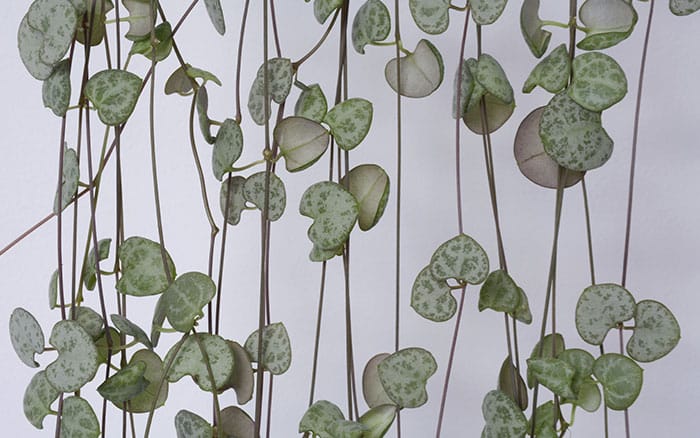Here’s a selection of wonderful looking hanging and trailing houseplants to beautifully complement your home.
Houseplants are enjoying a well-deserved revival and are the perfect way to add atmosphere to a home. They also bring that feel good factor induced by surrounding ourselves with living greenery. Don’t worry if your space is limited, there are plenty of houseplants with stems trailing downwards that can be placed on shelves or hung from ceilings without taking up valuable space. Long stems can also be trained artistically along the walls.
1. Ceropegia woodii (string of hearts)
These very pretty plants are an ideal choice if your space is very limited as they can still happily thrive and develop very long stems even if grown in something as small as a teacup. They are fast-growing and are extremely tolerant if neglected, making them an ideal choice for beginners. Their heart-shaped leaves mean they can make an ideal Valentine’s Day present.
- Feed with a weak solution of balanced nutrient fertiliser monthly during the summer
- Grows to 2m tall
- Cactus compost
- Prefers bright indirect light
- Temperature 18-24˚C and avoid draughts

2. Epipremnum aureum (golden pothos)
If you’re looking for a plant with larger leaves that loves low light levels, this variegated leaf variety could be the perfect choice. It has glossy green leaves streaked creamy yellow, and dislikes full sun as this can burn the leaves. Take care to not overwater, watering only when the soil becomes dry and keep it away from cold draughts.
- Feed with a general-purpose fertiliser during the summer months
- Grows to 3m length stems
- Well-drained, rich compost
- Medium, indirect light
- Temperature 10-24˚C and avoid draughts

3. Tradescantia zebrina (inch plant)
This is a great choice if you’re looking for a colourful, but easy to look after plant. The silvery, purple-green leaves are certain to brighten any room and the fact that it is fast growing means it will soon make an impact when hung from a ceiling or shelf. As with most other houseplants, allow the soil to dry out between watering, and reduce the amount of watering over the winter months.
- Feed with a general-purpose fertiliser during the summer months
- Grows to 2m length stems
- Well-drained, rich compost
- Bright to medium light
- Temperature 10-24˚C colder temperatures will slow down its growth

4. Senecio rowleyanus (string of pearls)
The small bead-like leaves that grow on trailing stems look wonderful in a hanging basket or placed on shelves where the stems can cascade freely. They are quite fast growing, so be sure to give them enough space to spread. Bright but indirect light is best, although they will also grow well in part shade. String of pearls are succulents and so are very drought tolerant, so don’t let plants sit in water. Feed with a weak solution of a balanced nutrient fertiliser during the summer months.
- Feed with a weak solution of a balanced nutrient fertiliser during the summer months
- Grows to 1m tall
- Cactus compost
- Bright but indirect light or partial shade
- Temperature 21-24˚C during summer months and 13-16˚C during winter months

5. Epiphyllum anguliger (fishbone cactus)
This cactus has fun, funky foliage – you can see how it got its common name. If you’re lucky, it will produce beautiful highly scented flowers. It does need high humidity, so a bathroom is an ideal place to display it. Take care to not overwater because this can cause the roots to rot, instead allow the top of the compost to dry out between waterings during the summer months and to dry out a little more than that during the winter. When fully grown, this plant can trail to 2m, but don’t worry because the stems can be cut back. Feed with weak cactus feed during summer months.
- Feed with a weak cactus fertiliser during the summer months
- Grows to 2m
- Cactus compost
- Medium to bright, indirect light
- Temperature 16-25˚C, but can tolerate lower temperatures for short periods

6. Senecio radicans (string of fishhooks)
For a great impact, place this plant hanging from a shelf or ceiling near an open window during some where the long stems can sway in a gentle breeze. It’s a fast grower, happy in either a bright, indirect light or partial shade. It’s another drought tolerant plant that hates being overwatered or allowed to sit in water. Trim stems if they become too straggly or long to keep the growth dense.
- Feeding with a weak balanced nutrient fertiliser solution monthly during the summer
- Grows to 1m
- Cactus compost
- Bright, indirect light or partial shade
- Temperature 18-24˚C but can tolerate temperatures as low as 10˚C during winter dormancy

7. Chlorophytum variegatum (spider plant)
This list wouldn’t be complete without mentioning the much-loved spider plant. Give it the right conditions and it will reward you with shiny healthy looking dark green and white striped leaves. There will also be lots of equally healthy-looking baby spiderling plantlets dangling down from the main plant. The secret to avoiding brown tips is to keep the plant misted and well-watered during its active growing season in the summer, then in winter reduce watering. Also, avoid placing it in direct sunlight as this may also cause brown scorch on the leaves. Placing the plant in the shade will slow its growth rate and its leaves may lose some of those white stripe markings.
- Feed monthly during growing season with weak solution but do not feed during winter months
- Grows to 50cm
- Well-drained, rich compost
- Bright indirect light preferred but will tolerate some shade
- Temperature 8˚C to 24˚C


Leave A Comment